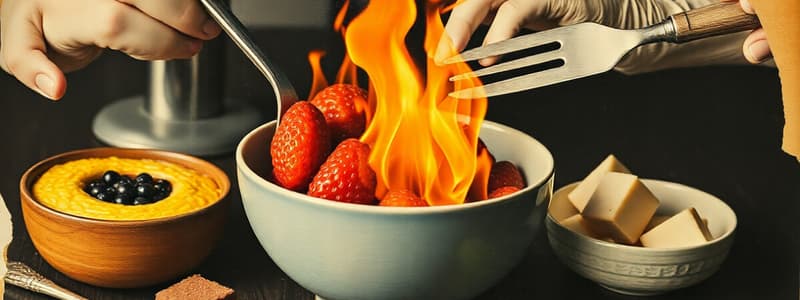Podcast
Questions and Answers
During cooking, what effect does heat have on proteins found in foods such as meat and eggs?
During cooking, what effect does heat have on proteins found in foods such as meat and eggs?
- Proteins dissolve completely, creating a smoother texture.
- Proteins become more elastic and expand in size.
- Proteins firm up, shrink, and lose water. (correct)
- Proteins break down into simple sugars, enhancing sweetness.
How do acids contribute to the cooking process of proteins, particularly in tougher cuts of meat?
How do acids contribute to the cooking process of proteins, particularly in tougher cuts of meat?
- Acids neutralize the flavors, requiring more seasoning.
- Acids toughen the connective tissue, requiring longer cooking times.
- Acids help tenderize the meat and quicken the protein firming process. (correct)
- Acids increase the water content within the protein.
When cooking foods rich in carbohydrates, such as fruits and grains, what chemical reaction occurs that results in the development of rich flavors?
When cooking foods rich in carbohydrates, such as fruits and grains, what chemical reaction occurs that results in the development of rich flavors?
- Oxidation
- Caramelization (correct)
- Gelatinization
- Emulsification
What is the primary effect of cooking on the fiber content of fruits and vegetables?
What is the primary effect of cooking on the fiber content of fruits and vegetables?
Why is the smoking point of a fat important to consider when selecting a fat for cooking?
Why is the smoking point of a fat important to consider when selecting a fat for cooking?
Which heat transfer method involves the movement of heat through air or liquid?
Which heat transfer method involves the movement of heat through air or liquid?
Which cooking method involves searing food and then cooking it in a small amount of liquid?
Which cooking method involves searing food and then cooking it in a small amount of liquid?
When roasting food, how is heat transferred to the food item?
When roasting food, how is heat transferred to the food item?
When deep-frying, what is the MOST important consideration regarding the fat used?
When deep-frying, what is the MOST important consideration regarding the fat used?
Why is proper air circulation important when roasting?
Why is proper air circulation important when roasting?
Which cooking method relies on heat conducted through the air and requires food to be close to an open flame?
Which cooking method relies on heat conducted through the air and requires food to be close to an open flame?
In the context of building flavors, what is the purpose of 'layering ingredients'?
In the context of building flavors, what is the purpose of 'layering ingredients'?
Why is balancing the five basic tastes (sweet, sour, salty, bitter, and umami) important in cooking?
Why is balancing the five basic tastes (sweet, sour, salty, bitter, and umami) important in cooking?
Which of the following herbs is MOST associated with Mediterranean cuisine due to its strong, earthy aroma?
Which of the following herbs is MOST associated with Mediterranean cuisine due to its strong, earthy aroma?
What is the primary reason for using herbs, spices, and seasonings in cooking?
What is the primary reason for using herbs, spices, and seasonings in cooking?
Which cooking method involves cooking food quickly in a small amount of fat in a hot pan while tossing the food?
Which cooking method involves cooking food quickly in a small amount of fat in a hot pan while tossing the food?
How does the presence of more connective tissue generally affect the cooking requirements of meat?
How does the presence of more connective tissue generally affect the cooking requirements of meat?
Why is it important to use an oven thermometer when using dry heat cooking methods?
Why is it important to use an oven thermometer when using dry heat cooking methods?
In the context of cooking fruits and vegetables, what is the effect of adding sugar to the cooking process?
In the context of cooking fruits and vegetables, what is the effect of adding sugar to the cooking process?
When deep-frying, what happens if the fat is heated beyond its smoking point?
When deep-frying, what happens if the fat is heated beyond its smoking point?
What is a key consideration when choosing a cooking method to maximize nutritional value?
What is a key consideration when choosing a cooking method to maximize nutritional value?
In the context of cooking, what is the purpose of 'layering ingredients'?
In the context of cooking, what is the purpose of 'layering ingredients'?
During which heat transfer method does heat spread through the movement of either air or liquid?
During which heat transfer method does heat spread through the movement of either air or liquid?
Why is balancing the five basic tastes important in cooking?
Why is balancing the five basic tastes important in cooking?
Which of the following best describes the 'braising' cooking method?
Which of the following best describes the 'braising' cooking method?
In stewing, what characteristic differentiates it from other moist cooking methods?
In stewing, what characteristic differentiates it from other moist cooking methods?
How do herbs, spices, and seasonings enhance flavors in cooking?
How do herbs, spices, and seasonings enhance flavors in cooking?
What is the primary purpose of using rosemary in Mediterranean dishes?
What is the primary purpose of using rosemary in Mediterranean dishes?
Why is it important to consider the material of the pot or pan when using conduction as the primary heat transfer method?
Why is it important to consider the material of the pot or pan when using conduction as the primary heat transfer method?
What distinguishes dry heat cooking methods from moist heat cooking methods?
What distinguishes dry heat cooking methods from moist heat cooking methods?
In contrast to butter, why is canola or safflower oil recommended for dry heat cooking methods?
In contrast to butter, why is canola or safflower oil recommended for dry heat cooking methods?
What is the purpose of placing food on a roasting rack when roasting?
What is the purpose of placing food on a roasting rack when roasting?
Flashcards
Heat effect on proteins
Heat effect on proteins
Firm up, shrink, and lose water when cooked.
Gelatinization
Gelatinization
Starches absorb water, swell, and thicken mixtures.
Conduction
Conduction
Heat transfer through direct contact.
Convection
Convection
Signup and view all the flashcards
Radiation
Radiation
Signup and view all the flashcards
Boiling
Boiling
Signup and view all the flashcards
Poaching
Poaching
Signup and view all the flashcards
Steaming
Steaming
Signup and view all the flashcards
Sautéing
Sautéing
Signup and view all the flashcards
Pan-searing
Pan-searing
Signup and view all the flashcards
Deep-frying
Deep-frying
Signup and view all the flashcards
Layering Ingredients
Layering Ingredients
Signup and view all the flashcards
Balancing Tastes
Balancing Tastes
Signup and view all the flashcards
Enhancing Aromatics
Enhancing Aromatics
Signup and view all the flashcards
Basil
Basil
Signup and view all the flashcards
Connective Tissue in Meat
Connective Tissue in Meat
Signup and view all the flashcards
Caramelization
Caramelization
Signup and view all the flashcards
Fiber
Fiber
Signup and view all the flashcards
Effect on fibers when cooking
Effect on fibers when cooking
Signup and view all the flashcards
Smoking Point
Smoking Point
Signup and view all the flashcards
Mechanical Convection
Mechanical Convection
Signup and view all the flashcards
Simmering
Simmering
Signup and view all the flashcards
Braising
Braising
Signup and view all the flashcards
Roasting
Roasting
Signup and view all the flashcards
Grilling
Grilling
Signup and view all the flashcards
Herbs and Spices
Herbs and Spices
Signup and view all the flashcards
Rosemary
Rosemary
Signup and view all the flashcards
Cinnamon
Cinnamon
Signup and view all the flashcards
Turmeric
Turmeric
Signup and view all the flashcards




